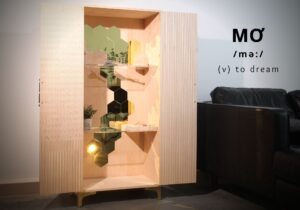Emotional Regulation through Material Stimulation
Adriana Sedman
See it On Campus: Level 2
Visitor InfoAcross from the wellness centre

a set of ceramic tools that address the sensory needs of neurodivergent people and how they relate to the regulation of emotions.
This project began by acknowledging the effects trauma has on the body and understanding the ways in which it manifests. I wanted to question how mental health can be managed through an awareness of the body. As the project has developed, there still remain many key issues that circled back to my original thought processes which I believe are valuable to touch on once more.
Living in a capitalist society that doesn’t care about your mental or physical health takes its toll and inherently creates the same feelings within oneself, neglect. This is met with a counter culture that labels all inner-work and therapeutic healing methods as pseudoscience, discrediting and creating a stigma around legitimate methods of healing. I’ve looked into many practices of care: lymphatic drainage massage, biofeedback, different methods of grounding, interplay, ritual, trusting intuition, somatic experiencing, breathwork, reiki. All of which relate to the original issue, that emotions being trapped in the body give rise to cause emotional stress which then results in physical tension which can build up over years leading to serious health implications.
The root issue being addressed is ultimately a need for a paradigm shift in mental health awareness that acknowledges the mind – body connection. This paradigm shift alludes to the fact that health is viewed through a binary lens. That there is physical health and mental health and that they are mutually exclusive. Through my research I have discovered how fundamentally intertwined our mental and physical states are and how much they influence one another. How somatic experiences can profoundly impact mental health. This kind of work can lead toward a greater sense of oneself while promoting confidence and autonomy over one’s own body.
Exploring Core concepts
Self
Soothing
is something I’ve always innately practiced but never had a name for. To self-soothe is to practice a habit that is formed and imposed by the self, that has a comforting effect, that calms the nervous system and is usually based in the senses. Commonly this looks like the repetitive clicking of a pen or the vigorous tapping of a foot. Even embracing oneself in affirming ways, like crossing arms or legs. This is something neurotypical and neurodivergent folks do alike, but the key difference is the frequency and severity of these needs. Often ND people use these habits in excess or as coping mechanisms which leads to being seen as disruptive in most NT spaces.
Emotional
Regulation
also known as self regulation is the ability to exert control over one’s own emotional state. Conversely, dysregulation, is a heightened sensitivity to emotional stimuli and a lessened ability to return to a normal emotional state within a reasonable amount of time
Sensory
Stimulation
is defined as a response in a sensory conductor to a form of stimulus. The key difference is over vs. under.
Overstimulation can look like extreme sensitivity to some stimuli, like certain textures or sounds. These sensory processing issues can lead to sensory overload and meltdowns causing one to completely shut down
Understimulation enacts a need to seek out positive sensory experiences which neurodivergent people enjoy with unique intensity.
Some common things that help regulate the nervous system are outlets for physical, often repetitive movement and / or tools. Sensory Tools can look very different for different people, this is simply my interpretation that caters to my peers and I’s needs.
These 3D Printed forms, casted in clay, are meant to be used intuitively on and with the hands.
Everyone needs to regulate their nervous systems and bodies, and I’ve identified through my research a major gap. Emotional regulation as a practice is targeted toward teaching children these skills and then almost abandoned as you age. There is a definite need, especially in neurodivergent adults lives, to hold space around the regulation of emotions. I feel that these practices of emotional regulation need to be practiced to be maintained, as they are just as important as one ages. Additionally many people were never taught these skills as children which has caused a lack of emotional intelligence in many adults. This lack of E.I. can be generationally passed down, creating a cycle of neglect.
When the nervous system becomes dysregulated, one may feel intensely over-stimulated or conversely, intensely under-stimulated causing one to feel so much or nothing at all. These two heightened states of being can be so severe to a point that is debilitating. As a survival mechanism on a daily basis we numb ourselves so much that we miss what our bodies are telling us. Self regulation is needed for reprogramming the nervous system. Creating control when one feels out of control, therefore gaining agency.
This project is ongoing and endless. My intention was to curate a series of objects that highlighted the power of touch and the sensitivity of the nerve endings in the hands. I wanted to create objects that can be held but also hold you back. I wanted this project to focus on personal, vulnerable, but shared experiences.
It was an exploration in the ways tools can be beneficial by simply being made available, in critical spaces for neurodivergent people as a way to recognize, understand and prioritize one’s own sensory needs.




